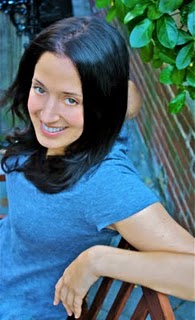 Today I am delighted to welcome author Diana Spechler, author of Skinny and Who by Fire.
Today I am delighted to welcome author Diana Spechler, author of Skinny and Who by Fire.
Overdosing on Yoga
In my late twenties, two different times, I got into the best shape of my life. The first time happened the summer I turned twenty-seven, when I was writing a novel set at a weight-loss camp for kids and went to work for ten weeks at a “fat camp” in North Carolina. At the end of that summer, during which I did nothing but exercise, I moved to New York, where I did nothing but work and drink Belgian beers in Manhattan bars. And so, sure enough, over the next six months, my body resumed its usual, nondescript shape. The trouble was, this time, because I’d briefly reached my ideal, I knew what I was missing: abs, for one thing. The ability to run a half marathon on a whim. The kind of energy that rendered sleep optional. This regression, this return to being human, was unacceptable.
“Try Bikram yoga,” my best friend told me. She had just quit smoking and taken up Bikram, a ninety-minute yoga class set in a 100-degree room. She swore it was saving her life. I agreed to try, although I secretly believed that yoga was to exercise what Thomas Kincade paintings are to fine art.
At my first class, the teacher told me that my job was just to stay in the room for the full hour and a half. I couldn’t imagine that would be a challenge, but in fact, it transcended challenge and teetered on impossible. The Bikram series consists of twenty-six postures, done twice each, in a strict order. For the first half hour, drinking water isn’t allowed. For the first hour, sitting isn’t allowed. The last half hour consists of postures done from the sitting and lying down positions, but it’s not much easier than the standing series. I wanted to run out of the room and cry and throw up. But I stayed, twisting my body into shapes I didn’t know a body could make. And when it was over, and I walked from the 100-degree room into the thirty-degree day, I floated.
And then all I could think about was doing it again. I canceled my gym membership and bought a membership to the Bikram yoga studio, a mat, and three pairs of Shakti shorts, the Bikram uniform.
If you’ve ever met a Bikram yogi, you know that we are a proselytizing bunch. In part, that’s because the postures and the heat create a drug-like effect on the brain. In other words, if you’re hanging out with someone who was just a week ago even-keeled with a variety of hobbies, and now, suddenly, she’s guzzling coconut water and droning on ad nauseum about how peaceful she feels, how her skin and organs and muscles have never been healthier, how she no longer has anxiety or insomnia, how her back pain and depression are healed, how you should really try it, or better yet, commit to a thirty-day challenge, if you’re listening and nodding and thinking, Is she high? the answer is, well, yes.
The Bikram euphoria is peerless. My best friend and I spoke on the phone several times a day to gush about the yoga in our new Bikram lexicon. It was as if we were thrilled to be in love with the same man, or as if we had had a baby together and wanted to do nothing but watch him blink and wiggle and pucker his lips.
“I swear,” one of us would say, “a few more months and I’ll be able to lock out in bow.”
“I balanced in toe stand today!”
“I’m communicating better in my relationship!”
“I haven’t had a cup of coffee in months!”
“I’m thinking I should go vegan.”
“Maybe even raw.”
“I might do a cleanse.”
“A fast.”
“Yes.”
“Yes!”
I began to shed weight like feathers. In my arms and thighs, my muscles began to bulge again. I had difficulty spending time with anyone without slipping yoga into the conversation. I was wonderful company. Like a cult member handing out “literature.”
My fat camp body had returned to me, but I no longer considered it satisfactory. The benefits of Bikram yoga, its disciples will tell you, are limitless. And so I sought improvement. I wanted my muscles to grow stronger, my body to grow leaner, my postures to deepen, my flexibility to reach contortionist standards. Now, my role models in the world were the yogis who competed in the national yoga championship (yes, that exists). I wanted to be like them—these people with zero percent body fat, who cupped a foot in their hands, unfurled the leg in front of them, and pressed their forehead to their knee, standing serenely, one-legged, without trembling.
When the New Year came, I committed to a 365-day challenge: 365 yoga classes in 365 days. The yoga studio wasn’t offering this challenge; I just invented it because I was a junkie. If I had to miss a day due to illness or travel, I would double up the next day.
Here’s one problem with obsession: It’s time-consuming. I now had fewer hours in the week for the things I had always cared deeply about. Like friends. Like writing. Like doing anything besides going to yoga, showering, and drinking Smart Water. And with my first novel on the brink of publication, I would soon go on book tour, where there wouldn’t be a Bikram studio on every corner. And then what was I going to do?
Time wasn’t the only problem. I was dehydrated. Once, my electrolytes depleted from several days in a row of doubling up on classes, I watched in horror as my fingers curled into a claw; I had to peel them open with my other hand. If I drank a beer, I was drunk after three or four sips. My skin broke out. My hair grew brittle.
When my body, no longer surprised by the intensity of the series, began to revert to its softer self, I began to question whether or not the drawbacks were worth it. In the Bikram community, although people will extol every benefit of the yoga — spiritual benefits, psychological benefits, health benefits — most won’t admit (as if there’s something anti-yogic about admitting it) that they do Bikram yoga, in part, for weight loss. I’d been loath to say so. “It keeps me centered,” I’d always said. But now that I had gained a few pounds, despite daily practice and no change in my diet, I felt frustrated and betrayed.
I didn’t make it through 365 classes. I came close, maybe to 300, but when my first novel came out, I got busy and let go. In the wake of an obsession, letting go is an enormous relief. I reduced my practice to five times a week, then three. And then finally, two years after I began, I quit, admitting that practicing the same postures over and over was no longer working for me.
I still dream about Bikram yoga sometimes. But in waking life, I belong to a gym, where I attend non-heated Vinyasa yoga classes twice a week, and also enjoy other exercises—weights classes, boot camp, swimming, reading magazines on the elliptical machine. I do miss being in perfect shape, but I don’t miss the wholly non-yogic panic I felt while overdosing on “yoga.
Meet Diana

She is also the author of two novels. Who By Fire is a story about what happens when people try to rescue one another. The kidnapping of a younger sister left her brother blaming himself and splintered their family. Thirteen years later, when the young girl’s remains are finally found, the surviving sister must attempt to bring her brother, who has been living as an Orthodox Jew in Israel, cut off from his family, home — and salvage their family. Diana considers Who By Fire “a family story. Specifically, it’s a story about moving toward or away from religion, decisions that are almost always intricately tied up with family.”
Although you would never guess it to look at her, Diana says that she has struggled with body image issues for as long as she can remember. And she deliberately set out to write a book on that topic. “I wanted to take a good, long, unflinching look at them. I was curious: What is this thing so many of us can’t get under control — the overeating, the under-eating, the obsessive exercising, the dysfunctional relationships we have with our scales and mirrors?” She worked at a “fat camp” for ten weeks, and Skinny is largely based upon that experience.



Comments are closed.